Written by Nancy Miorelli
Lots of people are curious and want to know if the animal they’re looking at is a boy a girl. You can’t tell the difference with every animal just by looking at it. If you can tell the difference based on how it looks, it’s called “Sexual Dimorphism“. That’s fancy talk that basically means “Two Morphs Based on Gender.”
So let’s get to the original question at hand.

These are two orchid bees representing different species.
Left: Euglossa obtusa
Right: Euglossa sp.
People are good at seeing color and so we tend to think this is an important feature when looking at animals. And in some cases, it works out! Lots of male birds are different colors than their female counterparts.
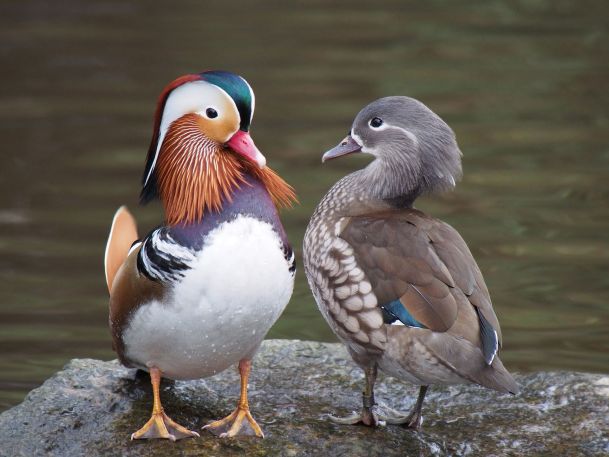
Here are a couple of ducks showing this. It’s really common in birds.
The left one is male.
PC: Francis C. Franklin (CC by SA 3.0)
With lots of butterflies you can tell boys and girls apart by their colors, but for a lot of other bugs this just isn’t the case. Take a look at the ladybugs below. They’re actually all the same species and you can’t pick boys from girls based on their color either.
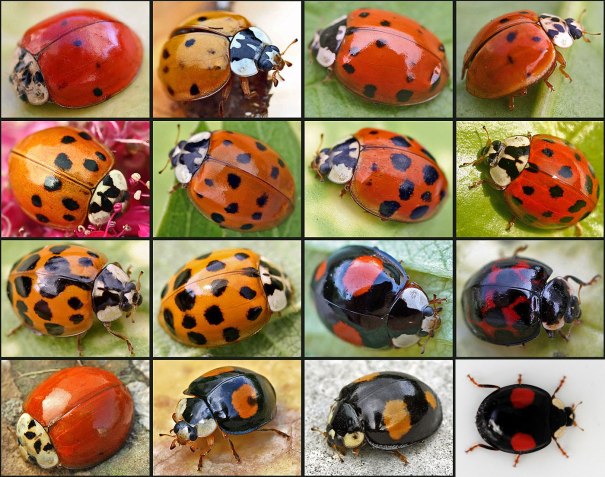
Good luck. We’re all the Mulicolored Asian Lady Beetle.
Just like how dogs that are the same breed can look different, these ladybugs do too.
PC: entomart
So let’s start off with the orchid bee, and then buzz through the rest of the bugs that you can tell apart.
1) Specific Specimens
Odorous Orchid Bees
Orchid bees are a group of bees with about 2oo species! So it makes sense that there would be a wide range of colors – and there are! Some orchid bees are blue, others are purple, many are green, and some are a bronze! They’re a beautiful group of insects that live in Central and South America. However, it’s pretty easy to tell males from females if you get up close.

So here’s a couple other Orchid Bees.
Left: Euglossa dodsoni
Right: Euglossa cyanura
Males have a fancy structure on their hind legs that helps them collect the smell of orchids. Only the males pollinate the flowers. Instead of getting nectar from the orchids, the males collect the fragrances. Like perfume, the males then attract females to a mating site.
Since the boys are the only ones that pollinate the orchids and collect the fragrances, they are the only ones that have the leg pouches.
Controlling Carpenter Bees
Carpenter bees are everywhere and they usually scare people as they buzz around park benches and railings. However, most of them that you see battling it out on your porch are male and they’re trying to secure some turf. The males are really easy to identify because they have a yellowish-white spot in the middle of their face. Male bees can’t hurt you so you shouldn’t be afraid of them!

Showing the male and female faces of the Virginia Carpenter Bee.
Beauty Pageant Butterflies
Butterflies generally fly during the day (but not always!). Because of this, in several species of butterflies the boys and girls are easily differentiated by their color. A great example are the Morpho butterflies. The males are a really bright shiny blue, but the females are more of a dusty ashen blue.

Male (top) and female (bottom) of the Giant Blue Morpho.
PC: Kayla Willis
Male Monarch butterflies have a pair of subtle dots on their hind wings that look white to us.

Male (left) and female (right) Monarch Butterflies (Danaus plexippus).
And if you think that’s tricky, some female butterflies reflect more UV light so the males can find them. So if we could see UV light, we could easily tell the males from the females. But we can’t! So they all look white to us. Although theoretically, the male should look more white than the female.
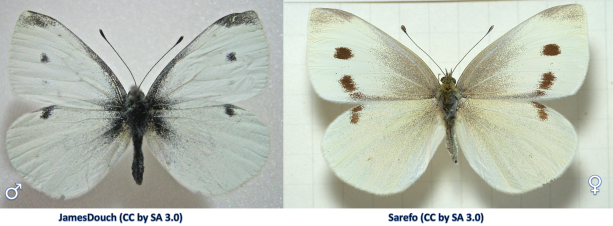
Male (left) and female (right) Cabbage White Butterflies (Pieris rapae).
Battling Beetles
There are a lot of beetles in the world. Most of them are small and brown and you probably wouldn’t even recognize one as a beetle if you saw one. But there are several beetles that have strikingly different features between the males and the females.
There are several types of Hercules beetles where the males have horns ranging from fairly adorable to downright intimidating, which help them shove other males around to claim females.
Even some scarabs have fancy ornaments on their head.
Some beetles think horns are too mainstream, and instead have bizarre male forms. Like the male Giraffe Weevils that engage in epic neck battles.
Or the male Harlequin Beetles that have legs that seem to stretch on forever. We’re not really sure what the legs do, but we think it helps the males grab onto females, or climb up trees and over obstacles more easily.
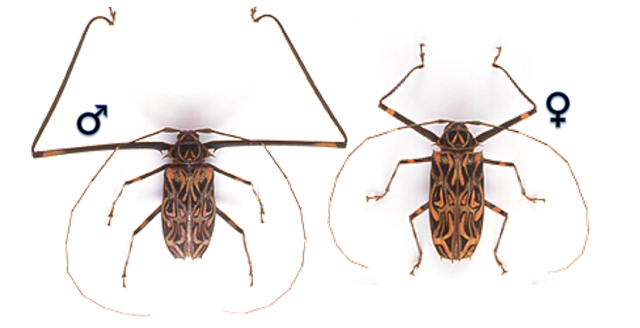
Male (left) and female (right) of the Harlequin Beetle (Acrocinus longimanus).
PC: Barbara Strnadova
Singing Cicadas
Lots of insects produce sound! Many times, they’re just too small for us to be able to hear them well. Others are really, really loud. Male cicadas are the only ones that sing, and you can even see the tymbals – the organ used to produce the sounds – on the males. There are some other bugs too for whom only the males are the primary vocal stars, but it may not be entirely appropriate for “Kids Questions.”
2) Size Matters
Almost all male insects are smaller than the females. Even the beetles with really big horns are skinnier and shorter than their female counterparts. The females have to invest a lot of energy into making eggs, and so they have a lot of fat stored up. Each female could be holding 100’s of eggs inside themselves – and all of that takes space. The males, however, just need to fly from female to female to fertilize eggs. So they don’t really need much in terms of resources. The same holds true for most spiders as well.
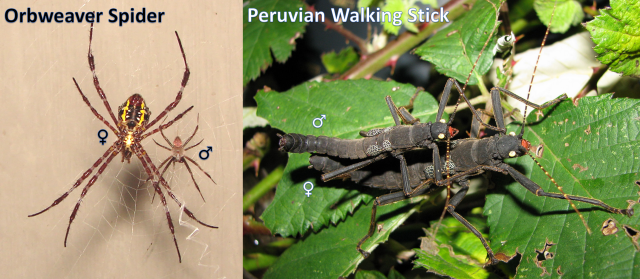
Left: Argiope appensa. – Angusmclellan (CC by 2.5)
Right: Peruphasma schultei – Drägüs (CC by SA 3.0)
3) Bug Bits
Wings
Most insects have wings. Some insects don’t need their wings and, over the course of evolutionary history, lost them. However, in a few groups, the males have retained their wings while the females lost them. Many leaf and stick insect males have a fully formed pair of wings which they use to fly to the females that sit camouflaged against the tree leaves.
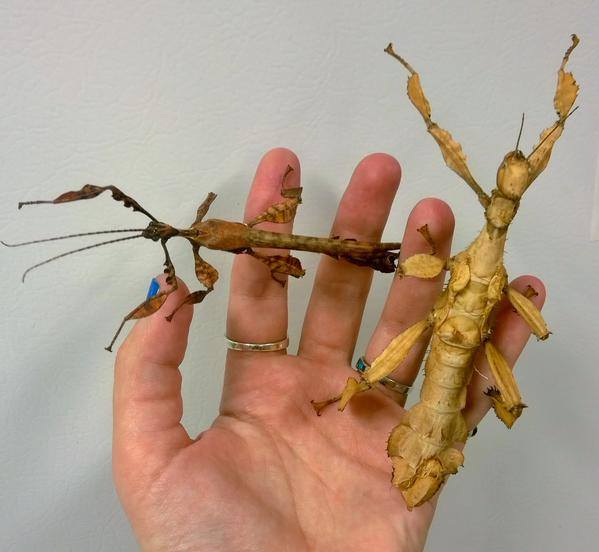
The Australian Spiny Stick Insect male (left) and female (right).
PC: Nancy Miorelli
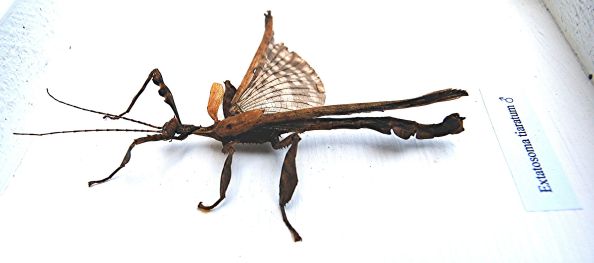
Male Australian Spiny Stick Insect (Extatosoma tiaratum) displayed so you can see his wings.
PC: Python (Peter Rühr) (CC by 3.0)
Both female and male ants have wings, but usually the winged ants that you see flying around are male. They kind of just chill in the colony until the females get annoyed and kick them out. Then they fly away to find a princess to mate with to start a new colony. The normal wingless ants you see puttering around on the pavement are the workers and are all female. In some cases the male just looks like a female with wings, and in other cases, like this driver ant, they look very different.

Male (top) and female worker (bottom) Driver Ant (Dorylus helvolus).
Egg Droppers
Female insects have a structure called an “Ovipositor”. Not all insects have a noticeable ovipositor, but if the bug has one – it’s female. In fact, wasps, bees, and ants can sting you because they’ve adapted their ovipositor to hold and inject venom! Some insects have really long ovipositors and others fairly short. But if it’s there – it’s definitely a female.
Antennae
The easiest group to tell boys from girls by antennae are moths. Male moths smell the females and follow her trail of perfume until he finds her. Then he’ll mate with her. Since, he sometimes has to travel miles to find his bae, he needs really sensitive antennae to smell her. Male moths, generally, have really thick feathery antennae while females, who don’t really have to do any sniffing, have less full antennae.

Polyphemus moth (Antheraea polyphemus) antennae showing the male (top) and the female (bottom).
This is true for some beetles as well – the males will have bigger, more grandiose antennae and the females will just have normal looking, or at least less ridiculous looking, antennae.
A lot of male wasps rock the curls and have antenna that curl at the ends. Their coloration is also usually slightly different, but the curly antennae give them away immediately.

These are two different species of Paper Wasp (Polistes) but the curly antennae trick still works in this group.
Big Eyed
Lots of male insects have bigger eyes than the females do. That’s because while some insects, like the moths I mentioned above, use smell to find females, other insects – like flies and bees – use visual cues. In some cases the difference it subtle, but in others the males have really big eyes compared to the females.
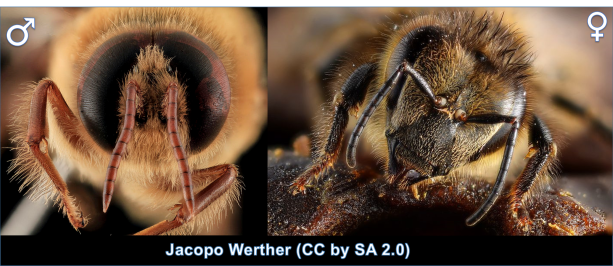
The better to see you with my dear!
Male (left) and female worker (right) Honey Bees (Apis mellifera)
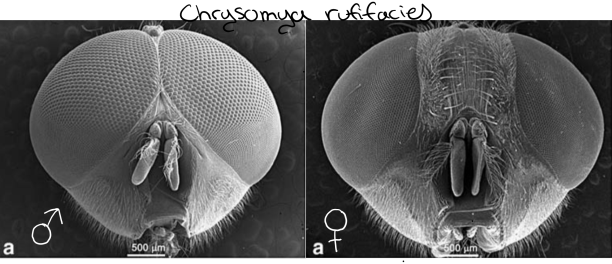
Male (left) and female (right) of a Blow Fly. (Chrysomya rufifacies)
PC: Sukontason et al. 2008
Or you could always be like the stalk eyed fly and plop your eyes way out on the sides. They actually don’t see too poorly, but it does wreck their flight pattern. Watch the video below to see how the males even make those stalks. They basically blow up them up like a balloon after hatching from their cocoon.
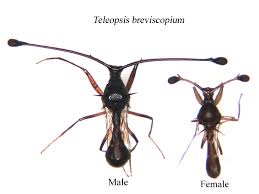
It gets all the ladies.
PC: The Small Science Collective
TL;DR
Orchid bees have many species and thus they come in a range of colors. The easiest way to tell boys from girls is to see if they have a specialized fragrance trapper on their hind legs. Males pollinate orchids and use their odors to attract females.
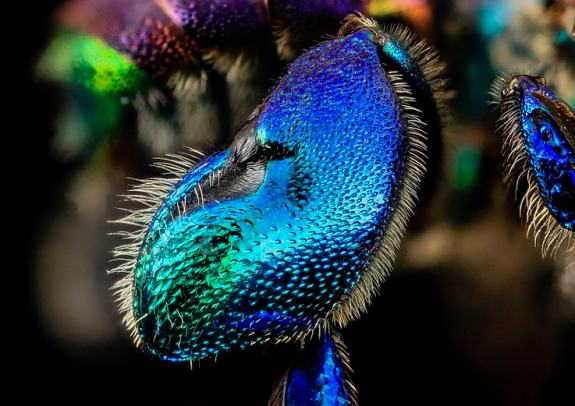
A closeup of the male fragrance trapper.
PC: USGS Bee Inventory and Monitoring Lab (CC by 2.0)
However, finding a consistent way to determine males from females is tricky. Most males are smaller than the females since they don’t have to invest energy into carrying around eggs. However, after that, it can be very dependent on the type of insect. Some groups the males have wings, bigger eyes, brighter colors, and/or larger antennae, while in other groups the females have a noticeable structure (ovipositor) used for laying eggs.
Basically, there are some go-to things you can look at but you have to know what group of insects you’re looking at first.

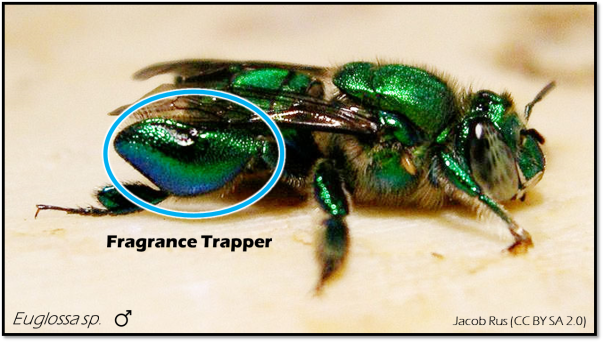

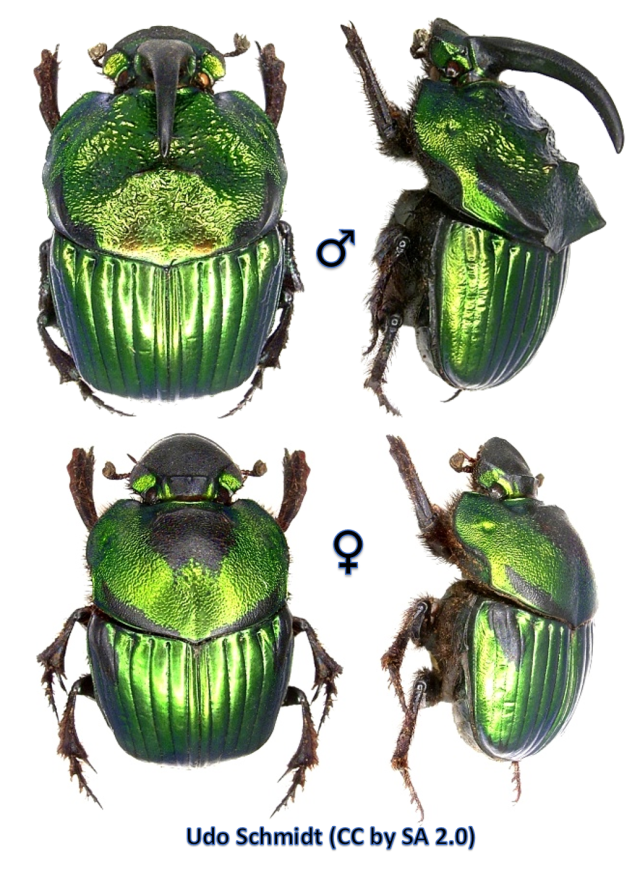
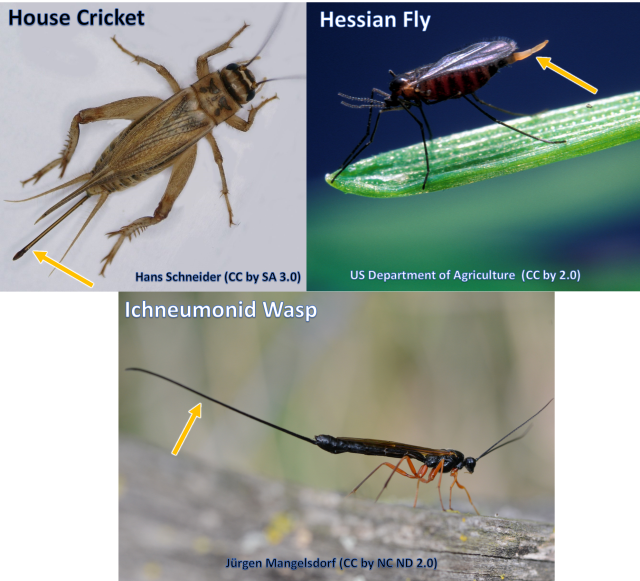
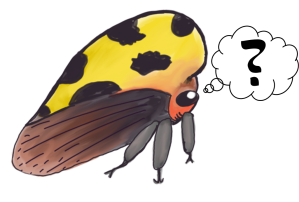
Pingback: What makes a good model organism? How are models different from one another? | Ask an Entomologist
Pingback: Honeybee genetics: how do they work? | Ask an Entomologist
Pingback: A Bug Landed On Me. Now What? | Ask an Entomologist
How do u know when your common black ground beetle is a boy or a girl f you only have one.
LikeLike
In a lot of ground beetles, the sexes look pretty similar. Many times, you can only truly tell through dissection.
I wish I had a better answer, but a lot of beetles can be hard to sex.
LikeLike
Ok
Thx anyway
LikeLike
Pingback: How do butterflies make boys and girls? | Ask an Entomologist
How can you tell if a Phasmatidae stick bug is a boy or girl?
LikeLike
Usually male phasmids have a large bump on the end of their abdomen which is their genetalia. But a lot of times in Phasmids the males look really different from the females (males are skinnier, and have wings where the females could be really large and wingless).
For example, the Malaysian Jungle Nymphs have crazy different looking males and females.
https://en.wikipedia.org/wiki/Heteropteryx_dilatata
~Nancy
LikeLike
What about box elder bugs???
LikeLike
Box elder bugs don’t have an obvious sexual dimorphism other than size. The females tend to be bigger.
LikeLike
Great blog!😊
LikeLiked by 1 person
Pingback: 10 Bed Bugs Facts Everyone Should Know | Bed Bugs Remedy